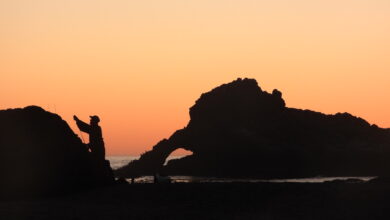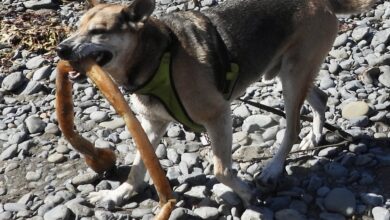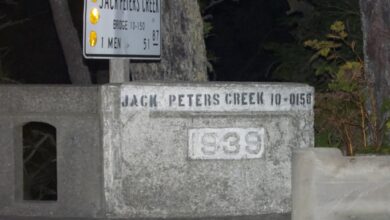Westport grave mystery: Could it be a “peace” of unknown history?
Two brothers who died on a ranch in Rockport in the 1940s are buried side by side in Westport with a message on their wooden graves that defies written history.
Peace!
The two graves in the Westport Cemetery contradict all the published history of the peace sign, that two-fingered salute that once was also the symbol of Mendocino.
When we were visiting the Ten Mile-Westport Cemetery (that’s its historic name, but it’s now called just the Westport Cemetery), we found gravestones from the 1940s that flash a big peace sign, and if anybody had doubts about the meaning, there is the peace dove below.
However, if you believe that history is intact and can be found with a Google search these graves simply can not be there.
Everything that I could find on the web postulates unequivocally the peace sign originated in 1958, more than a decade after it the salute to the future from the Sampson brothers. I went to Wikipedia, which I don’t really trust , then to Britanicca, which I do, and both told exactly the same story (nearly word for word, so the entry may have been copied by the writer of the Wikipedia piece)
The Encyclopedia Britannica article goes so far as to say that the origins of the peace sign is one part of its story that is not controversial. Sorry guys, Im about to ruin your day! The writers seemed delighted about finding a fact nobody contested and put it in bold.
“Thankfully, the symbol has a clear history, and its origin is not so controversial. The modern peace sign was designed by Gerald Holtom for the British Campaign for Nuclear Disarmament in 1958. The vertical line in the center represents the flag semaphore signal for the letter D, and the downward lines on either side represent the semaphore signal for the letter N. “N” and “D”, for nuclear disarmament, enclosed in a circle. Holtom also described the symbol as representing despair, with the central lines forming a human with its hands questioning at its sides against the backdrop of a white Earth. It is said that Holtom originally considered using a Christian cross but disliked its association with the Crusades and ultimately chose something he considered to be more universal. Read the rest of the encyclopedia account here:
So what of the peace sign being on graves that predated Holtom’s supposed creation of it by 17 years?????
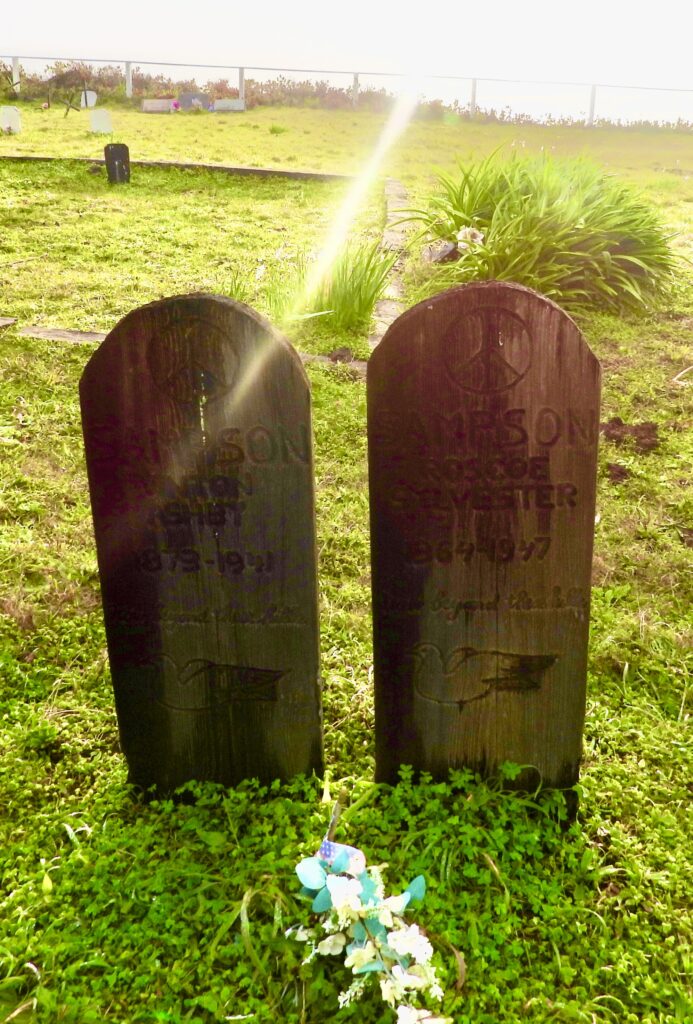
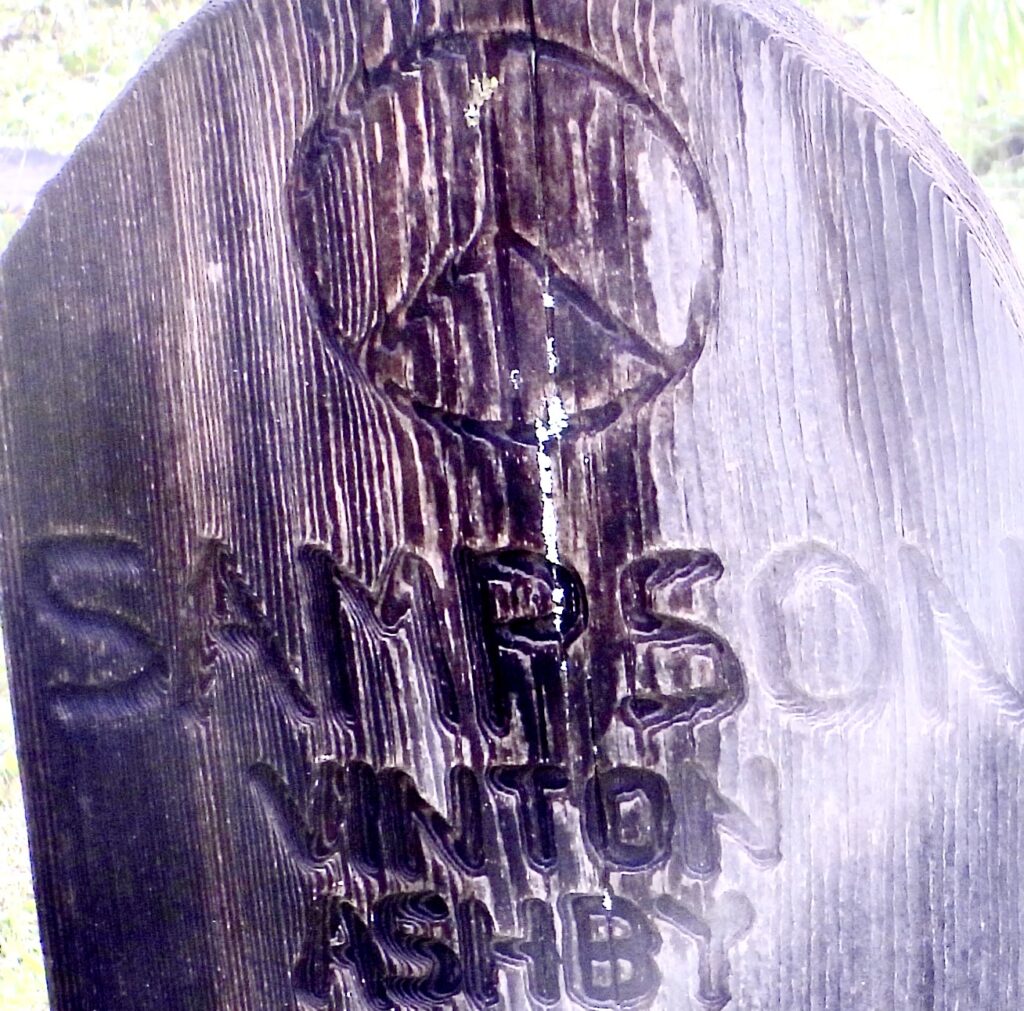
Could the brothers have been buried long after death, been moved from another cemetery, or the headstones put up later? That seems preposterous when looking at these weathered wooden graves. Who would bury them 17 years later and then put peace signs and doves on their graves? And the charming “gone beyond the hills” Who were these Sampsons? I found a bit of their history from a 1947 obituary for Roscoe in the Mendocino Beacon. Roscoe was a retired sheep shearer who was born in Iowa and traveled the country shearing sheep until he came to live on the DeVilbiss ranch in Rockport, which was then a town just north up the road from Westport . Nothing much left of Rockport now. The paper reported he had a big funeral and many friends. A brother and nephew both made long trips for the funeral. The obituary misspells his brother Vinton’s name as Dinton. I’d like to know more about these people. The family history is rich online. Members of the Sampson family were on the Mayflower, according to a book written by a man whose last name was Vinton. The genealogy of the brothers shows they and their parents were born in the Midwest. While Vinton had no local editorial, unless his name was spelled a third way, I found his World War I draft card, which revealed he was born in Wisconsin. I also found out that he spent his life as a shepherd. I have created a novel from this grave already. Vinton went to war and had a horrific experience in Europe. He came back and joined a peace movement and headed to the furthest corner of the earth he could find, Westport where he found solace among sheep. He wrote to his older brother, Roscoe, who came to Westport to retire after his career of shaving the sheep came to an end. Shearing sheep sounds bucolic but it is an awful, stinky foul job full of struggles with sheep who bawl bloody murder and act like they are being barbecued alive until you release them and they find out their wool is gone and they are ecstatic. Then they run in happy circles. Vinton’s grave does not indicate he was a veteran. Maybe that goes with the peace message? I think he should still get a wreath on Memorial Day for his service.
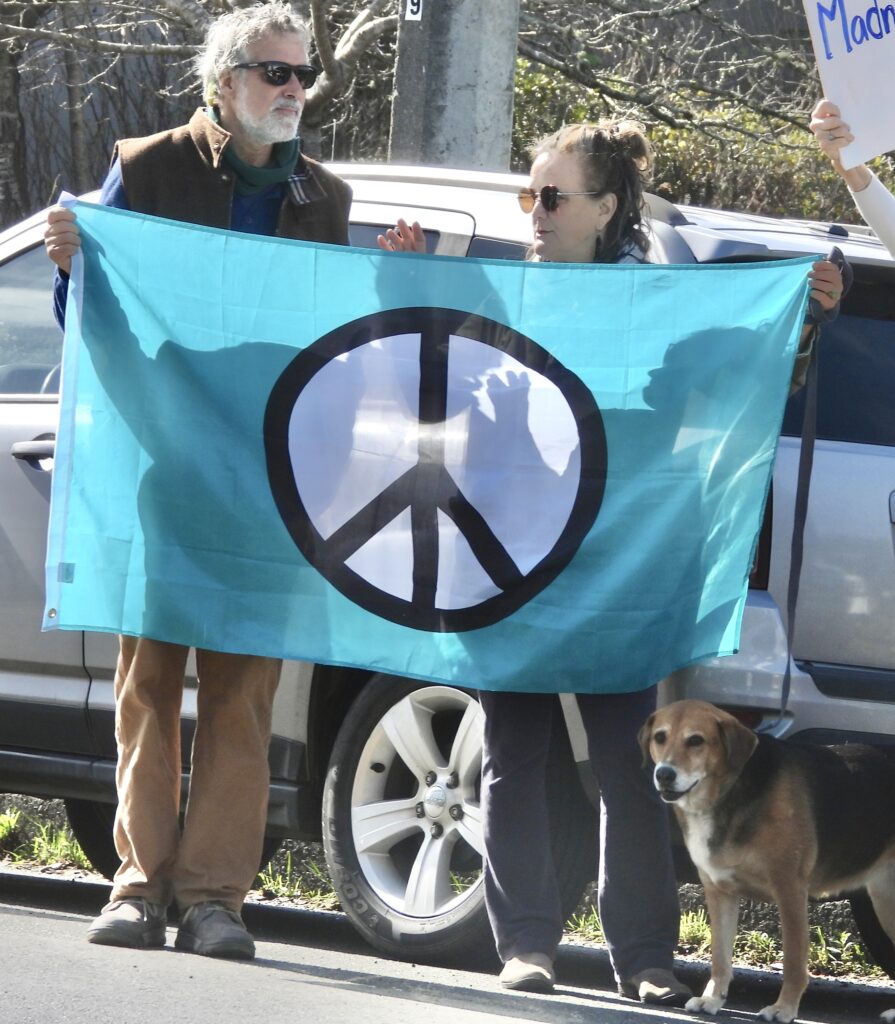
The location of the peace sign graves of the Sampsons is in place with other graves from that time period? Are we about to change history here? Does anybody know any more about the graves or the Sampsons? Below is the list of all the burials in the Westport Cemetery, unfortunately, it says only when people died, which is obvious from the graves, but not when they were buried:
People buried in Westport Cemetery
Among all the crazy things that this generation believes is that Google searches or even the entire Internet covers pretty much everything. That misses by a mile. I can tell you about two major events in California history that I was there for that cannot be found anywhere on the Internet now. Well one major, the other pretty cool.
More on that later.
Next, we go to the Peace Dove. If you randomly Google search, you could easily be led to the preposterous conclusion that the peace dove originated with Pablo Picasso’s 1949 sketches of the peace dove. Of course, Picasso would likely laugh harder at this nonsense than anyone else if he were still here. The Wikipedia and Britannica get this one correct, thankfully. The history is as follows:
The peace dove originated in the very earliest Christian church. The dove was from the Torah and the Jewish scriptures originally. But the bird, drawn in the shape you see here on the grave came to represent peace through early Christianity.
The peace dove comes from the story of Noah, who sent a raven out first but the big black bird decided not to comply and never returned. Ravens are still too smart and disagreeable to serve anyone but themselves.
Next, Noah sent a dove out three times to try to find life on the earth God had just wiped out. The dove returned the second time with an olive branch in his mouth indicating the water had receded far enough down from the Great Flood for a tree to appear. The ark was stuck on the top of Mt Ararat and only mountains were visible.
Noah, was not a Jew, as the first Hebrew born was Isaac, the son of Abraham, a descendant of Noah, according to the Biblical account. Before Isaac, Abraham fathered Ishmael, who is the patriarch of Islam.
The Hebrews used the dove as the symbol of themselves and the hope for the future. Christians took this message and tweaked the meaning of the dove to mean peace. The dove came to peace to both religions and pretty much the entire world and was portrayed in art from the Dark Ages through the Renaissance and modern times to mean peace. An artist could perch a tiny dove in a treetop of his painting of a battle or ceremony and add peace to the mesage of his or her artwork.
Picasso, of course, was well versed in art history and was using it to create a symbol for the French communist party, not creating it.
But taken together, the Wesport Grave says “PEACE” twice and there is absolutely no doubt that is the message. So was the peace sign invented prior to the time history books say it was? If so by who? If not, how did it get on these graves?
I last sheared sheep as a kid on my grandparents farm. Thirty years later I met a professional sheep shearer who had become a software man in Texas and later got rich. He said that day on the farm was his life epiphany. He decided this occupation was too filthy and horrible and he was going to college and never touch a sheep again.
I’ve included a third grave mystery and plan to talk to Gary Quinton soon about what he knows.
Westport grave mystery: could it be a peace of unwritten history?
Two brothers who died on a ranch in Rockport in the 1940s are buried side by side in the Westport Cemetery with a message on their wooden graves that defies written history.
Peace.
The two graves in the Westport Cemetery contradict all the published history of the peace sign, that two-fingered salute that once was also the symbol of Mendocino.
When we were visiting the Ten Mile-Westport Cemetery (that’s its historic name, but its now called just the Westport Cemetery, we found gravestones from the 1940s that flash a big peace sign, and if anybody had doubts about the meaning, there is the peace dove below.
However, if you believe that history is intact and can be found with a Google search these graves simply can not be there.
Everything that I could find on the web postulates unequivocally the peace sign originated in 1958, more than a decade after it apparently saluted the future from the Sampson brothers. I went to Wikipedia, which I don’t really trust then to Britanicca, which I do, and both told exactly the same story (nearly word for word, so the entry may have been copied by the writer of the Wikipedia piece)
The Encyclopedia Britannica article goes so far as to say that the origins of the peace sign is one part of its story that is not controversial. The writers seemed delighted about finding a fact nobody contested and put it in bold.
“Thankfully, the symbol has a clear history, and its origin is not so controversial. The modern peace sign was designed by Gerald Holtom for the British Campaign for Nuclear Disarmament in 1958. The vertical line in the center represents the flag semaphore signal for the letter D, and the downward lines on either side represent the semaphore signal for the letter N. “N” and “D”, for nuclear disarmament, enclosed in a circle. Holtom also described the symbol as representing despair, with the central lines forming a human with its hands questioning at its sides against the backdrop of a white Earth. It is said that Holtom originally considered using a Christian cross but disliked its association with the Crusades and ultimately chose something he considered to be more universal. Read the rest of the encyclopedia account here:
So what of the peace sign being on graves that predated Holtom’s supposed creation of it by 17 years?????
Could the brothers have been buried long after death, been moved from another cemetery, or the headstones put up later? That seems preposterous when looking at these weathered wooden graves. Who would bury them 17 years later and then put peace signs and doves on their graves? And the charming “gone beyond the hills” Who were these Sampsons? I found a bit of their history from a 1947 obituary for Roscoe in the Mendocino Beacon. Roscoe was a retired sheep shearer who was born in Iowa and traveled the country shearing sheep until he came to live on the DeVilbiss ranch in Rockport, which was then a town just north up the road from Westport . Nothing much left of Rockport now. The paper reported he had a big funeral and many friends. A brother and nephew both made long trips for the funeral. The obituary misspells his brother Vinton’s name as Dinton. I’d like to know more about these people. The family history is rich online. Members of the Sampson family were on the Mayflower, according to a book written by a man whose last name was Vinton. The genealogy of the brothers shows they and their parents were born in the Midwest. While Vinton had no local editorial, unless his name was spelled a third way, I found his World War I draft card, which revealed he was born in Wisconsin. I also found out that he spent his life as a shepherd. I have created a novel from this grave already. Vinton went to war and had a horrific experience in Europe. He came back and joined a peace movement and headed to the furthest corner of the earth he could find, Westport where he found solace among sheep. He wrote to his older brother, Roscoe, who came to Westport to retire after his career of shaving the sheep came to an end. Shearing sheep sounds bucolic but it is an awful, stinky foul job full of struggles with sheep who bawl bloody murder and act like they are being barbecued alive until you release them and they find out their wool is gone and they are ecstatic. Then they run in happy circles. Vinton’s grave does not indicate he was a veteran. Maybe that goes with the peace message? I think he should still get a wreath on Memorial Day for his service.
The location of the peace sign graves of the Sampsons is in place with other graves from that time period? Are we about to change history here? Does anybody know any more about the graves or the Sampsons? Below is the list of all the burials in the Westport Cemetery, unfortunately, it says only when people died, which is obvious from the graves, but not when they were buried:
People buried in Westport Cemetery
Among all the crazy things that this generation believes is that Google searches or even the entire Internet covers pretty much everything. That misses by a mile. I can tell you about two major events in California history that I was there for that cannot be found anywhere on the Internet now. Well one major, the other pretty cool.
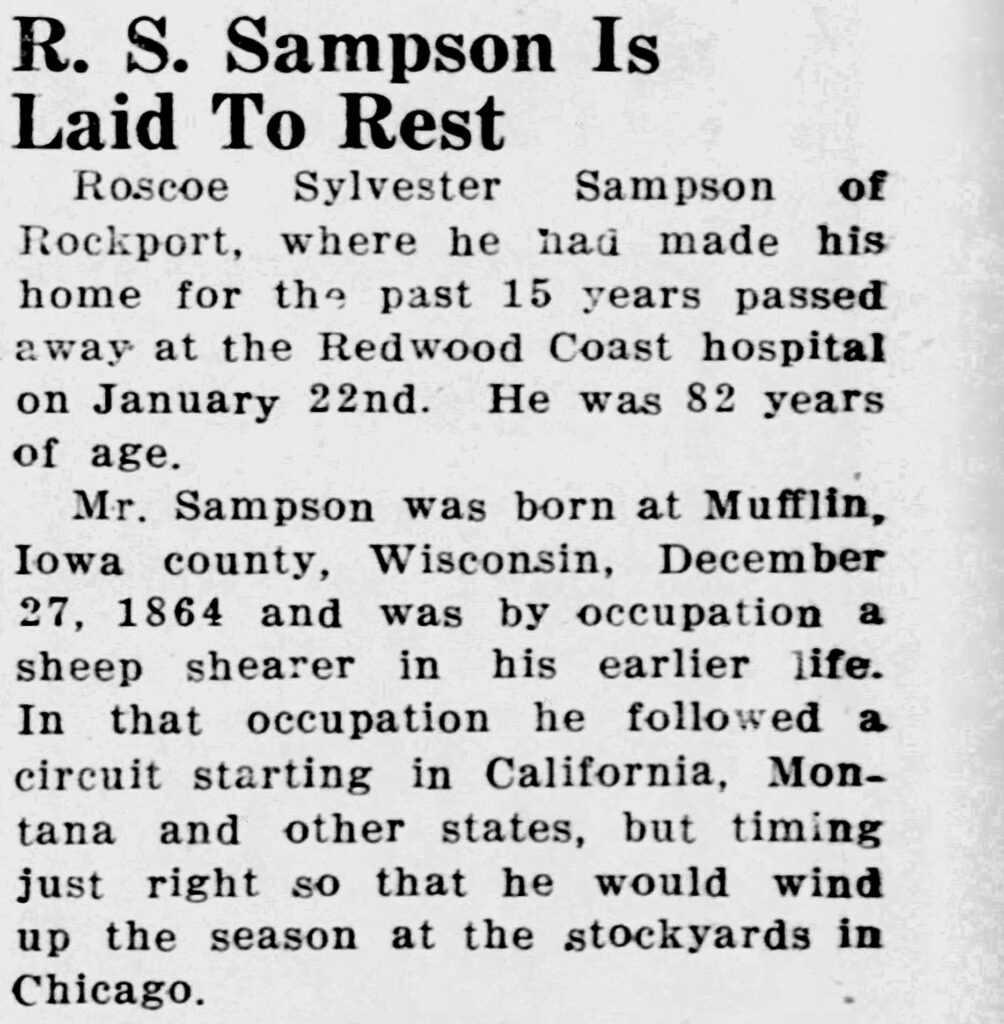
More on that later.
Next, we go to the Peace Dove. If you randomly Google search, you could easily be led to the preposterous conclusion that the peace dove originated with Pablo Picasso’s 1949 sketches of the peace dove. Of course, Picasso would likely laugh harder at this nonsense than anyone else if he were still here. The Wikipedia and Britannica get this one correct, thankfully. The history is as follows:
The peace dove originated in the very earliest Christian church. The dove was from the Torah and the Jewish scriptures originally. But the bird, drawn in the shape you see here on the grave came to represent peace through early Christianity.
The peace dove comes from the story of Noah, who sent a raven out first but the big black bird decided not to comply and never returned. Ravens are still too smart and disagreeable to serve anyone but themselves.
Next, Noah sent a dove out three times to try to find life on the earth God had just wiped out. The dove returned the second time with an olive branch in his mouth indicating the water had receded far enough down from the Great Flood for a tree to appear. The ark was stuck on the top of Mt Ararat and only mountains were visible.
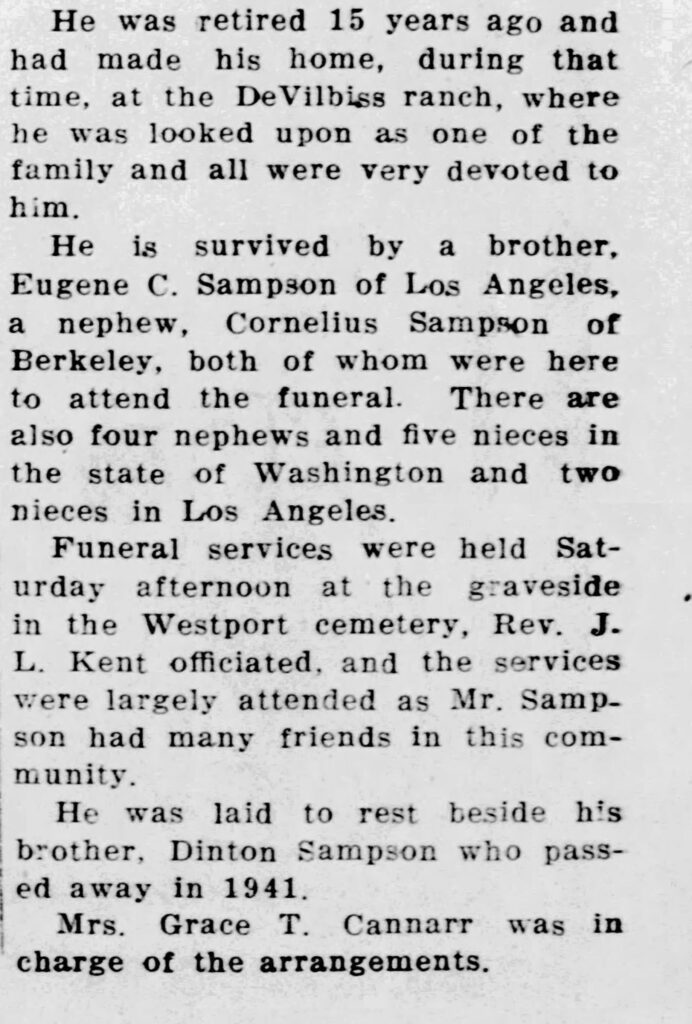
Noah, was not a Jew, as the first Hebrew born was Isaac, the son of Abraham, a descendant of Noah, according to the Biblical account. Before Isaac, Abraham fathered Ishmael, who is the patriarch of Islam.
The Hebrews used the dove as the symbol of themselves and the hope for the future. Christians took this message and tweaked the meaning of the dove to mean peace. The dove came to peace to both religions and pretty much the entire world and was portrayed in art from the Dark Ages through the Renaissance and modern times to mean peace. An artist could perch a tiny dove in a treetop of his painting of a battle or ceremony and add peace to the mesage of his or her artwork.
Picasso, of course, was well versed in art history and was using it to create a symbol for the French communist party, not creating it.
But taken together, the Wesport Grave says “PEACE” twice and there is absolutely no doubt that is the message. So was the peace sign invented prior to the time history books say it was? If so by who? If not, how did it get on these graves?
I last sheared sheep as a kid on my grandparents farm. Thirty years later I met a professional sheep shearer who had become a software man in Texas and later got rich. He said that day on the farm was his life epiphany. He decided this occupation was too filthy and horrible and he was going to college and never touch a sheep again.
I’ve included a third grave mystery and plan to talk to Gary Quinton soon about what he knows.
Who is this guy?
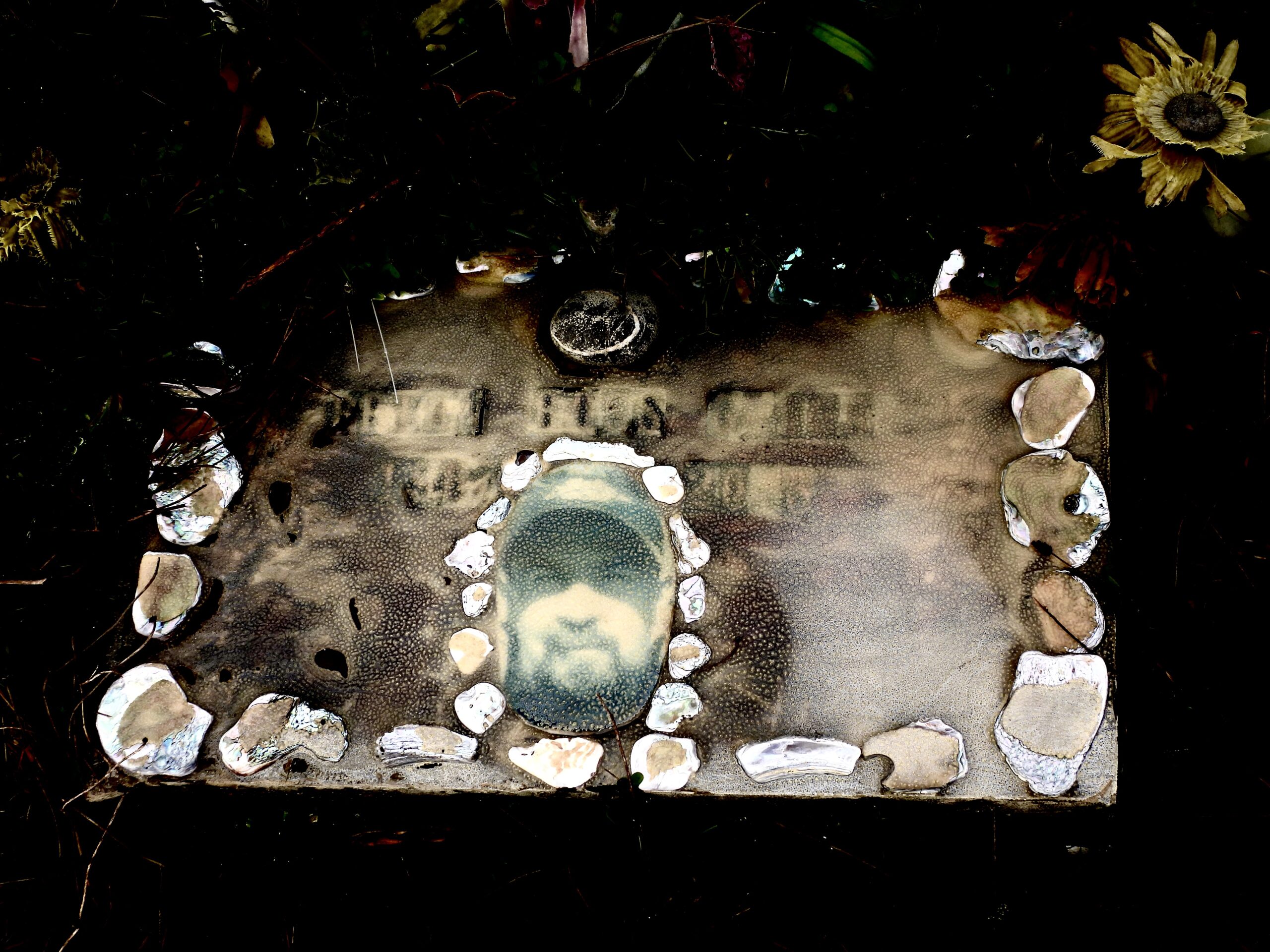
Let’s put a name to him and drink a beer in his honor at Tall Guy!

